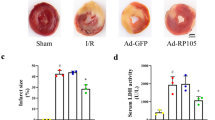Abstract
Purpose
Ischemia/reperfusion results in tissue damage, a rapid increase in cytokines and chemokines and inflammatory cell infiltration. Herein we investigated the ability of a selective TLR2/4 antagonist, Sparstolonin B (SsnB), to protect rat cultured left ventricular tissue (LV) slices from hypoxic injury by inhibiting the myocardial inflammatory response independent of inflammatory cell infiltration.
Methods and Results
Media Lactate dehydrogenase (LDH) levels were measured to reflect hypoxia-induced cytotoxicity and cell injury with and without SsnB. Incubation with SsnB (15 and 30 μM) significantly reduced by 20 and 40 %, respectively, the amount of LDH released from the hypoxic LV slices. TUNEL staining showed that SsnB significantly attenuated the levels of hypoxia-induced apoptotic cells from 61.5 ± 4.0 to 27.0 ± 2.1 (15 μM SsnB) and 23.5 ± 2.2 (30 μM SsnB) cells/unit area. Similarly, the Periodic Acid-Schiff (PAS) staining of ischemic areas in untreated hypoxic LV slices was increased 17 fold from 0.26 ± 0.09 to 4.41 ± 0.43 %, while in hypoxic slices incubated with 15 and 30 μM of SsnB, the PAS positive ischemic areas were increased by only 6.4 fold to 1.66 ± 0.39 % and 3.8 fold to 1.00 ± 0.22 %, respectively. Rt-PCR confirmed that MCP1 and IL-6 expression during hypoxia was elevated by 2 and 4 fold, respectively, while their up-regulation was significantly inhibited (i.e., <0.7 fold increase) by SsnB.
Conclusion
The selective TLR2/4 antagonist, Sparstolonin B, can substantially protect LV myocardium via its ability to inhibit injury resulting from hypoxic myocardial-generated inflammation. Accordingly SsnB has potential as a therapeutic agent for the attenuation of myocardial ischemia-reperfusion injury.




Similar content being viewed by others
References
Eltzschig HK, Eckle T. Ischemia and reperfusion–from mechanism to translation. Nat Med. 2011;17:1391–401.
Feuerstein GZ, Young PR. Apoptosis in cardiac diseases: stress- and mitogen-activated signaling pathways. Cardiovasc Res. 2000;45:560–9.
Murphy E, Steenbergen C. Mechanisms underlying acute protection from cardiac ischemia-reperfusion injury. Physiol Rev. 2008;88:581–609.
Poth JM, Brodsky K, Ehrentraut H, Grenz A, Eltzschig HK. Transcriptional control of adenosine signaling by hypoxia-inducible transcription factors during ischemic or inflammatory disease. J Mol Med. 2013;91:183–93.
Liang Q, Wu Q, Jiang J, Duan J, Wang C, Smith MD, et al. Characterization of sparstolonin B, a Chinese herb-derived compound, as a selective Toll-like receptor antagonist with potent anti-inflammatory properties. J Biol Chem. 2011;286:26470–9.
Liang Q, Yu F, Cui X, Duan J, Wu Q, Nagarkatti P, et al. Sparstolonin B suppresses lipopolysaccharide-induced inflammation in human umbilical vein endothelial cells. Arch Pharm Res. 2013.
Marchant DJ, Boyd JH, Lin DC, Granville DJ, Garmaroudi FS, McManus BM. Inflammation in myocardial diseases. Circ Res. 2012;110:126–44.
Peri F, Piazza M. Therapeutic targeting of innate immunity with Toll-like receptor 4 (TLR4) antagonists. Biotechnol Adv. 2012;30:251–60.
Kanzler H, Barrat FJ, Hessel EM, Coffman RL. Therapeutic targeting of innate immunity with Toll-like receptor agonists and antagonists. Nat Med. 2007;13:552–9.
Patel H, Shaw SG, Shi-Wen X, Abraham D, Baker DM, Tsui JC. Toll-like receptors in ischaemia and its potential role in the pathophysiology of muscle damage in critical limb ischaemia. Cardiol Res Pract. 2012;2012:121237.
Lin E, Freedman JE, Beaulieu LM. Innate immunity and toll-like receptor antagonists: a potential role in the treatment of cardiovascular diseases. Cardiovasc Ther. 2009;27:117–23.
Eefting F, Rensing B, Wigman J, Pannekoek WJ, Liu WM, Cramer MJ, et al. Role of apoptosis in reperfusion injury. Cardiovasc Res. 2004;61:414–26.
Santini D, Abbate A, Scarpa S, Vasaturo F, Biondi-Zoccai GG, Bussani R, et al. Surviving acute myocardial infarction: survivin expression in viable cardiomyocytes after infarction. J Clin Pathol. 2004;57:1321–4.
Roubille F, Barrere-Lemaire S. Apoptosis following myocardial infarction: cardiomyocytes and beyond. Eur J Clin Invest. 2013.
Fink SL, Cookson BT. Apoptosis, pyroptosis, and necrosis: mechanistic description of dead and dying eukaryotic cells. Infect Immun. 2005;73:1907–16.
He Y, Xi J, Zheng H, Zhang Y, Jin Y, Xu Z. Astragaloside IV inhibits oxidative stress-induced mitochondrial permeability transition pore opening by inactivating GSK-3beta via nitric oxide in H9c2 cardiac cells. Oxid Med Cell Longev. 2012;2012:935738.
Halestrap AP, Clarke SJ, Javadov SA. Mitochondrial permeability transition pore opening during myocardial reperfusion–a target for cardioprotection. Cardiovasc Res. 2004;61:372–85.
Mughal W, Dhingra R, Kirshenbaum LA. Striking a balance: autophagy, apoptosis, and necrosis in a normal and failing heart. Curr Hypertens Rep. 2012;14:540–7.
Prech M, Marszalek A, Schroder J, Filas V, Lesiak M, Jemielity M, et al. Apoptosis as a mechanism for the elimination of cardiomyocytes after acute myocardial infarction. Am J Cardiol. 2010;105:1240–5.
Nah DY, Rhee MY. The inflammatory response and cardiac repair after myocardial infarction. Korean Circ J. 2009;39:393–8.
Fahmi A, Smart N, Punn A, Jabr R, Marber M, Heads R. p42/p44-MAPK and PI3K are sufficient for IL-6 family cytokines/gp130 to signal to hypertrophy and survival in cardiomyocytes in the absence of JAK/STAT activation. Cell Signal. 2013;25:898–909.
Yamauchi-Takihara K, Ihara Y, Ogata A, Yoshizaki K, Azuma J, Kishimoto T. Hypoxic stress induces cardiac myocyte-derived interleukin-6. Circulation. 1995;91:1520–4.
Bhattacharya K, Farwell K, Huang M, Kempuraj D, Donelan J, Papaliodis D, et al. Mast cell deficient W/Wv mice have lower serum IL-6 and less cardiac tissue necrosis than their normal littermates following myocardial ischemia-reperfusion. Int J Immunopathol Pharmacol. 2007;20:69–74.
Liu Q, Wang J, Liang Q, Wang D, Luo Y, Li J, etal. Sparstolonin B attenuates hypoxia-reoxygenation induced cardiomyocye inflammation. Exper Biol Med. 2014;239:376–84
Acknowledgments
This work was supported by the National Heart, Lung and Blood Institute at the National Institutes of Health (R21-HL-089483 to J.S.J. and R21AT006767 and R01HL116626 to D.F.).
Disclosures
None declared.
Author information
Authors and Affiliations
Corresponding author
Rights and permissions
About this article
Cite this article
Liu, Q., Li, J., Jubair, S. et al. Sparstolonin B Attenuates Hypoxia-Induced Apoptosis, Necrosis and Inflammation in Cultured Rat Left Ventricular Tissue Slices. Cardiovasc Drugs Ther 28, 433–439 (2014). https://doi.org/10.1007/s10557-014-6545-6
Published:
Issue Date:
DOI: https://doi.org/10.1007/s10557-014-6545-6




